QNAP TS-219P Turbo NAS Review

Today we are going to discuss a 2-bay network-attached storage server with iSCSI from QNAP dedicated to the SOHO and home users. It supports 2.5″ and 3.5″ SATA hard drives, and is promised to offer hardware design for storage expansion, and high data access performance.
QNAP has long established itself as a leading maker of Network Attached Storage products. The company’s NASes feature high quality, broad functionality, good performance and stable operation. The only downside that users are likely to complain at is the pricing, but that refers to other brands’ products as well. It is often much cheaper to assemble a new computer or modify an old one to use as a NAS. On the other hand, it takes some time and effort and requires the user to have the necessary skills to set a hand-made NAS up and running with all the required applications. A regular computer is also going to be larger and noisy and to consume more power. Thus, it turns out that modern NASes, notwithstanding their high price, have a good chance of being purchased by people who want a ready-made solution they can just power on and use. Besides serving as a data repository, a modern NAS can also perform various other functions, serving as a media server, download station, video surveillance system, etc.
Typical NASes are designed for 1 to 5 hard disk drives, but I guess that 2-disk models seem to be the optimal choice for home. They feature an appealing price/capacity ratio and offer some configuration flexibility. And today, I will tell you about a 2-disk NAS from QNAP which is called TS-219P.
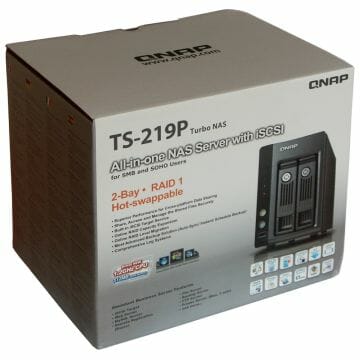
By the way, the company produces two more 2-disk models: a higher-performance Atom-based TS-239 Pro and an entry-level TS-210 with an 800MHz ARM processor and without a hot swap feature.
Package and Accessories
The packaging is good: solid cardboard and a lot of information. Everything necessary is included into the box, excepting hard drives. Besides the NAS, you will find an external power adapter (12V, 5A) with power cord, an Ethernet cable, HDD fasteners, two keys for the HDD bays, a brief installation guide, a disc with software, and a few leaflets in there. That’s a classic set of accessories with nothing extra.
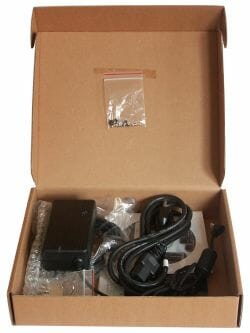
The software and documentation on the disc are accessible through an auto-running shell. Besides PDFs with user manuals, the disc contains QFinder for looking for devices on the network and initial setup, QGet for controlling the file download system, and QNAP NetBak Replicator for some basic backup options. The first two programs are available in Mac OS X versions as well.
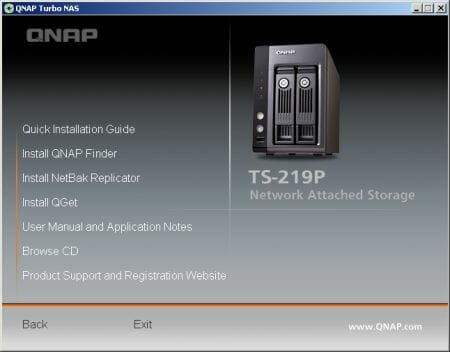
Exterior Design
The device looks stylish, demure and functional. The case is aluminum with a plastic front panel. The color is quite original, bronze-like. A part of the panel with indicators is black and glossy. Below it there are indicators of disk, LAN and eSATA activity. Two buttons and a USB port can be seen lower. The Power button has an integrated status indicator. The other button is used for copying data from the USB drive plugged into the front USB port.
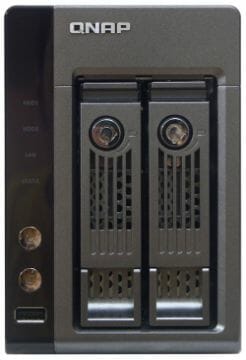
At the back you can see a fan grid, a Reset button and an abundance of connectors: two eSATA ports, two USB 2.0 ports, a Gigabit Ethernet port (RJ-45), and a power connector. The two eSATA interfaces are quite a rare thing to be seen in a dual-disk NAS.
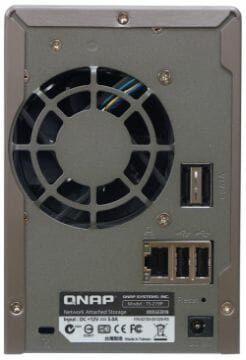
The device is small at only 22×15.5×10.3 centimeters but its power adapter is external. Four rubber feet help reduce vibrations.
Summing up, the exterior of this NAS is very good. The hot swap feature is perhaps not crucial for a home user, but such drive bays make it easier to assemble the NAS and reduce the risk of the user’s breaking something.
Hardware Configuration
The QNAP TS-219P is based on the ARM platform: a Marvell 6281 processor at 1.2GHz, 512 megabytes of DDR2 SDRAM, a 16MB flash memory chip (for the bootloader). The main SATA controller is integrated into the processor, the external SATA ports are based on a JMB362 chip. A GL850G USB-hub is also present.
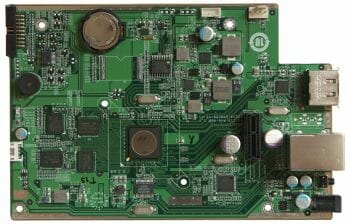
The 6281 model is currently the top representative of Marvell’s Kirkwood series. The chip features a high clock rate, low power consumption (it even lacks a heatsink), integrated SATA ports, Gigabit Ethernet, and USB. This is in fact the top-end all-in-one solution for NASes based on the ARM architecture.
There is a console connector on the PCB but it will only be needed in cases of emergency because the NAS supports standard network access.
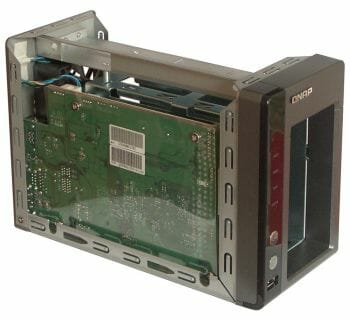
Inside the drive there is an iron chassis on which the main PCB, a card with the front indicators and buttons, and a card with SATA connectors for HDDs are fastened. The NAS is cooled by a 70x25mm fan (Y.S.Tech FD127025LB, 12V, 0.09A) with 4-pin connection. With some agility, you can get to it and replace or clean it. The noise level is quite low, so this NAS can be utilized at home without any discomfort.
In the ordinary operation mode the NAS with the test HDDs would consume about 30W. In the sleep mode with the HDDs turned off it consumed a mere 5 watts.
Prep Work
This NAS does not offer anything new in terms of assembly. The procedure is perfectly standard: install your HDDs on the frames, insert the frames into the NAS, connect the LAN cable and power adapter, and turn the NAS on.
The frames have two sets of mounting holes for both 3.5-inch and 2.5-inch HDDs. You may want to use the latter drives to reduce the level of noise and power consumption, but 2.5-inch HDDs have lower storage capacities. There is usually no difference between the smaller and larger types of HDDs in terms of performance when it comes to using them in a NAS.
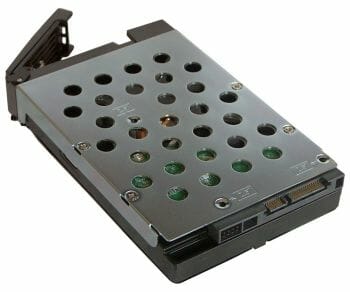
QNAP’s products use some space on the installed HDDs for storing firmware code. So, you need to initialize the device when you turn it on for the first time.
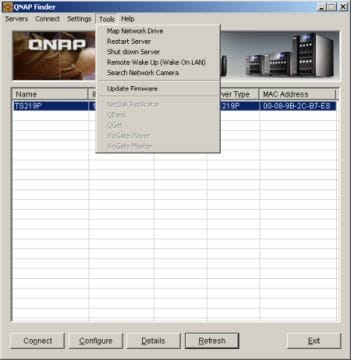
There are two ways to do that. You can use the included QNAP Finder tool or access the NAS via a browser. The second way is going to be useful for users of operating systems other than Windows and Mac OS X.
The Finder tool helps you set the NAS up quickly by answering a few questions (password, server name, network address, date and time, etc). Then the firmware is installed and you can get to work.
If you go the second way, you have to find the NAS’s IP address first (by looking up the logs of your home router) or use the name NASxxxxxx where xxxxxx is the last three bytes of the MAC address (indicated on the NAS’s case) and open this address in your web-browser. The mini-server integrated into the flash memory will install the full firmware code and initialize the HDDs. This method only takes a web-browser and can be performed on nearly any client computer. Then, you just browse through a few pages, similar to the Finder tool, to set up the basic parameters of the device.
I used firmware 3.1.2 build 1014 for this test session.
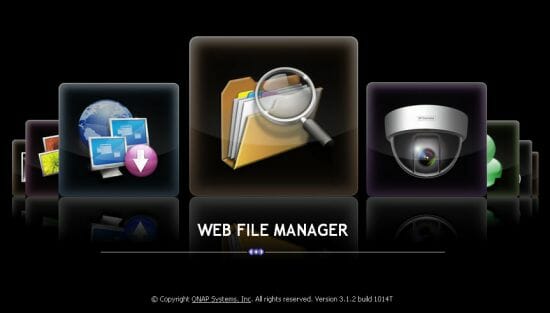
Starting from version 3.0, QNAP’s web-interface is based on Ajax technology, which makes it pretty and functional. The interface is available in multiple languages. You can choose the language to use manually or in your browser settings.
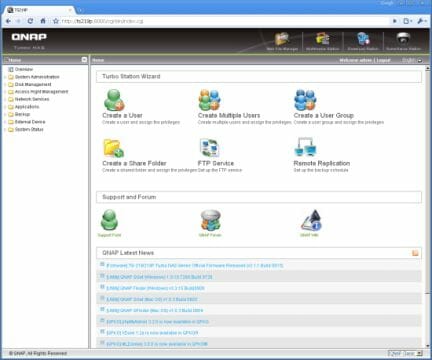
All active features of the device and a few links to Web resources can be seen in the start page. A minor inconvenience is that you have to reenter your name and password when switching between them.
Basic Functionality
QNAP’s products are an example to many second-tier manufacturers in terms of functionality. Although new firmware versions are released on a regular basis, the basic set of network features has long been polished off. I will now give you a brief description of the NAS’s settings and capabilities, most of which you can find in other such products. The differences only concern hardware features (e.g. a NAS may have two LAN controllers or a faster processor) or market positioning.
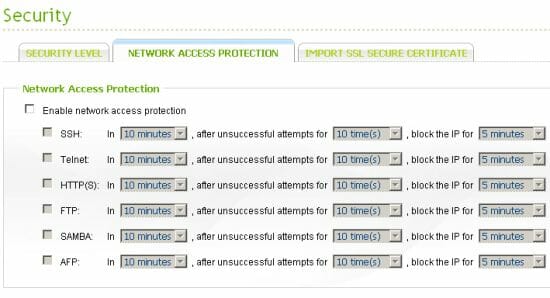
So, the TS-219P is connected to a LAN via a Gigabit Ethernet port. It supports manual or automatic address setup, connection speed selection (100 or 1000Mbps), and Jumbo Frames up to 9000 bytes. The NAS has an integrated DDNS client. For additional protection there is an integrated IP address filter and a system that prevents access if password guessing is detected. Importing SSL certificates is supported for integration into corporate networks. The NAS can be quickly and automatically identified on a LAN through UPnP and Bonjour protocols.
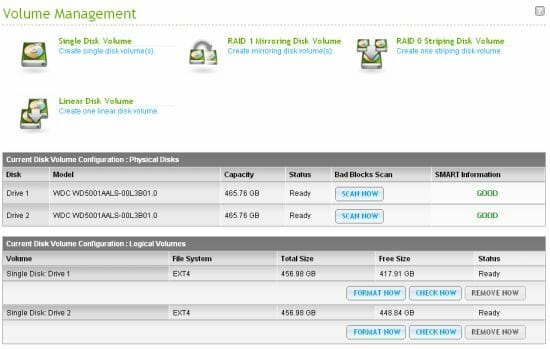
One or two HDDs can be used to store data. You can unite them into JBOD, RAID0 or RAID1 arrays. External drives connected via eSATA cannot be joined in. You can change the configuration of the disk subsystem without losing your data. For example, you can add one more drive to build a mirror array or replace the drives in a mirror sequentially to enlarge the storage capacity. This is a useful feature that is supported by few manufacturers as yet. You can monitor the status of your HDDs using SMART and run a file system check if you suspect errors.
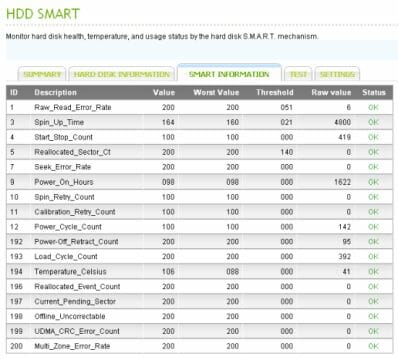
The TS-219P supports the trendy iSCSI technology, too. It is not particularly interesting for home users but can be called for in business applications. With newer firmware, the NAS can work not only as a server but also as an iSCSI client.
Network access to data stored on the NAS is provided via all modern protocols: SMB/CIFS, AFP, NFS, FTP, and HTTP. Most of them have special settings. For example, you can assign the NAS to a domain on a Windows network or you can specify an AppleTalk zone. The FTP protocol has the highest number of parameters. You can change ports (including ports for passive mode), enable Unicode support, limit the number of sessions and the data-transfer speed. Encryption is supported, so you can organize secure access to files via the Internet. You can select the necessary 8-bit codepage for non-Unicode clients.
The integrated network recycle bin for SMB/CIFS and AFP protocols should be handy for incautious users. When a file is deleted, it goes first into this bin. It is only when you clean the recycle bin that the file is really lost.

A modern NAS must have an access control system and nothing more efficient than the conventional username/password has been invented as yet. For each user you can specify a disk quota and create a personal shared folder. Users can be united into groups. Unfortunately, there is no way to specify the real name, email or comment for a user. If you’ve got over a dozen of users, this may provoke some confusion. Besides the integrated user database, you can use Windows domain integration.
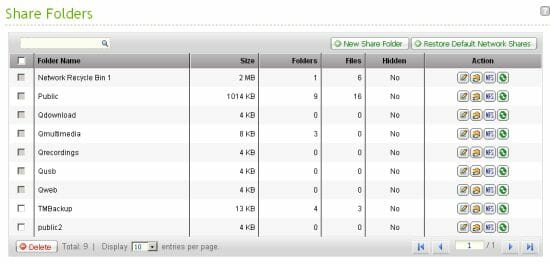
Users are assigned access rights to shared folders. After the first disk volume is formatted, the system automatically creates a few folders (Public, Qmultimedia, Qdownload, etc). You cannot remove them and the only way of shutting them down it to prohibit access to them for all users.
Access rights are assigned to users and user groups by setting checkmarks in a table with entries like No access, Read only, Read and Write.
The restrictions you specify work for Windows networks, AFP and FTP. The NFS protocol allows a single pair of parameters (access type/client addresses) for each resource. A handy feature is that the information about the size and number of folders is shown in a common table. You can also create comments for NAS resources.
External Devices
As I’ve written above, the NAS offers three USB 2.0 and two eSATA ports for external devices. The latter interface is almost as fast as the internal HDDs. Unfortunately, you cannot integrate eSATA drives into RAID arrays. You can only access them via an appropriate network folder. The same goes for USB drives. When you connect an external drive to the NAS, resources called USBDiskN and eSATADiskN are created where N is the volume number in the order of identification. You can specify any access rights for these folders and they will keep on working when you unplug and connect a new device.
USB hubs are not supported, but three ports should be enough even considering a printer and a UPS. Multiple HDD partitions are supported, too. The NAS can work with FAT, NTFS, EXT3 and EXT4. If necessary, you can format your external drive using the NAS’s web-interface.
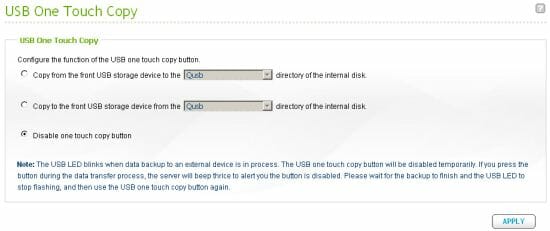
If you plug your drive into the front USB port, you can then press the special button to copy data from and to the drive. Copying is done with a NAS resource specified in the settings or into a folder created specially for each such operation. A synchronization mode is available for this feature.
The TS-219P can serve as a print-server for USB printers. Scanners in all-in-ones are not supported.
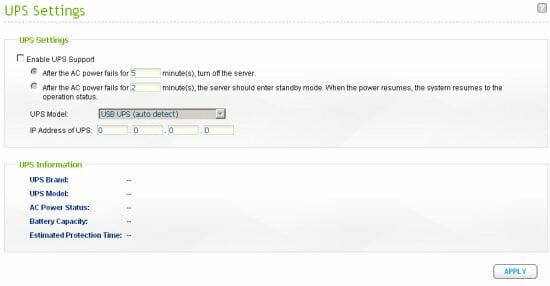
You can also connect a UPS into a USB port to correctly shut the NAS down in case of a power failure. The system can start up automatically later if its power supply is restored. Many UPS models from APC and compatibles are supported. You can find the entire list on the QNAP website. You can use SNMP devices, too.
System Settings
First off, you can change the name of the server. Then, you can set up the internal clock which supports Internet-based synchronization. The group of hardware parameters includes the option of turning off the Reset button (the administrator’s password cannot be restored then), choosing a period of inactivity before shutting the HDDs down, turning on the indication and a free space shortage warning, and disabling the integrated speaker. There is a rather advanced system of controlling the speed of the fan: you can specify speed thresholds and an operation algorithm.
For the NAS to work by a schedule, you can program a list of (a maximum of 15) events like turn on and off and reboot, specifying the precise time and date (by days of the week). You can shut the NAS down or reboot via the web-interface, too.
It is easy to monitor all events occurring on the NAS. Besides an ordinary log file, there is an individual list into which all operations via individual protocols can be written (this logging feature is off by default to save the NAS’s resources). There is also a page where you can view all current connections.
The NAS can notify you about its events by email or SMS. The former option requires such settings as a server address and port, authentication, encryption support and sender’s address. For SMS, you have to register on the paid service Clickatell. The Syslog support should be useful for corporate networks.
Integration into a large network can be facilitated by the SNMP support. The required settings (a MIB profile) are loaded from the NAS.
The interface offers three pages for monitoring the NAS’s status: hardware status (the processor and memory usage, the temperatures of the HDDs and system, etc), activity of its services and flash-based graphs.
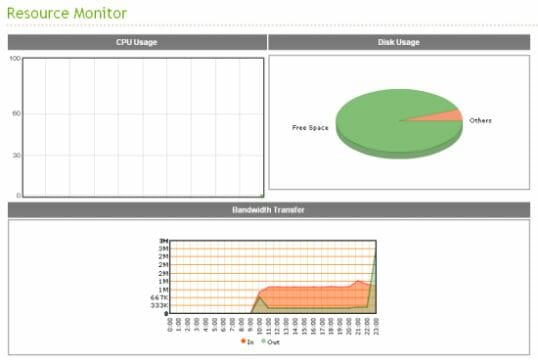
The configuration can be saved and restored. The firmware can be updated. The settings can be reset to their defaults.
Additional Features
Although NASes are often used for storing backup copies of data from users’ computers, you should take care about your NAS, too. One way is to back up data from specified shared folders on external drives. You can choose the backup device (it must be connected to the NAS), schedule and mode (copying or synchronizing).
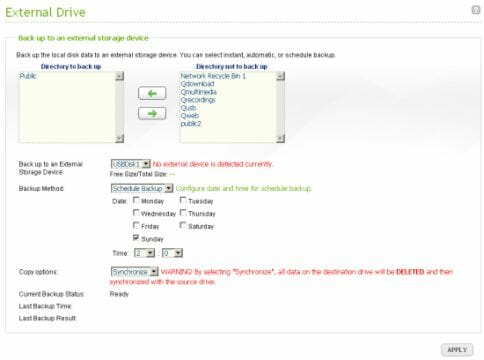
The second way allows creating network backups to another NAS or an Rsync server. Unfortunately, the conventional SMB and FTP protocols are not supported. You can define multiple tasks with different parameters (the selection of resources, schedule, etc).
Professionals may be interested in the opportunity of establishing a web-server on the NAS. It supports PHP, MySQL and can host rather complex projects. Additionally, you can install ready-made packages with the WordPress or Joomla systems.
The NAS provides full-featured file access via a standard web-browser interface, so you can easily work with your data via the Internet from any computer (of course, if your router is set up appropriately and has a real IP address). Standard operations like creating folders, uploading files, renaming/copying/moving/deleting are all supported.
The multimedia aspect of the TS-219P is presented by three services: an extended web-based file manager, iTunes and UPnP AV/DLNA servers. The former allows viewing photos, including EXIF information, also as a slideshow, and add comments to them. This feature has been long available in QNAP’s products but it’s not very useful. The iTunes server is going to be of much more help as it can store all your music and synchronize it with popular players from Apple. Data (files in the formats mp3, wav and m4a) are only indexed in the Qmultimedia folder. There is no web-interface for the Firefly software utilized here, but you can change some parameters of this service by editing the configuration file via the console.
QNAP has been long using one of the best implementations of a multimedia service, the TwonkyMedia program. It is used in the TS-219P, too. It can index various file formats including HD video such as mkv, ts and m2ts. It can work with any folders and is compatible with PlayStation 3 and Xbox 360. This service can be configured via an exclusive web interface.
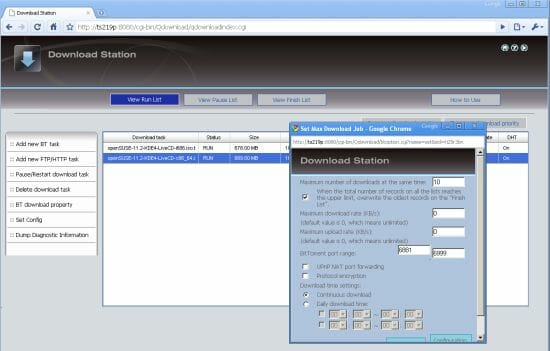
An autonomous file download service is present, too. It supports FTP/HTTP and BitTorrent. Despite the high overall performance of the NAS, the number of simultaneous downloads is limited to 10. There are settings for BitTorrent only: you can choose ports, speed limits, and a schedule for the service to work by. DHT and protocol encryption are supported. For each task you can specify a seed period (in hours) after the download is complete. Download tasks can only be managed by the device administrator. Besides the browser, this can all be made through a special program called Qget. It is available in versions for Windows and Mac OS X.

The download service is quite functional overall, but if you are planning to work with torrents heavily, you may want to install the alternative client called transmission from Optware.
The last original feature is the video surveillance system for IP cameras. QNAP offers a separate line of products for this application, so it must have been easy to add this feature into NASes as well. The TS-219P supports a maximum of two video cameras. If you want more, you need a higher-performance or a specialized solution. The NAS is compatible with MJPEG and MPEG4 cameras. The settings are few: selecting a camera and choosing video recording parameters. You can also specify a recording schedule, make the camera begin to record when the motion sensor is triggered on (this feature must be supported by the camera itself), define parameters for data storage and rerecording. You can work with the system by using two screens: viewing the image live or watching recordings. This is only available with the Internet Explorer browsers as the system uses special plugins.
Functionality Enhancements
This feature is all right. The NAS supports console access via telnet or SSH, which means you can add new modules almost without limitations. For higher security you can change the standard ports of these services. If you don’t want to study Linux deeply, you can use preassembled QPKG packages installed via the web-interface. There are over a dozen such packages available already. Besides these two options, you can use QPKG to install the Optware package management system and install modules later via the console.
Performance
I tested the TS-219P using Intel’s NASPT 1.7.0 software and 500GB Western Digital Caviar Black WD5001AALS drives. The testbed configuration is the same as in our previous NAS reviews: an Intel Core 2 Duo processor at 1.8GHz, 4 gigabytes of system memory, a Gigabit Ethernet controller and Microsoft Windows Vista.
The NAS is connected to the PC via a Gigabit Ethernet router with Jumbo Frames support. The NAS is set up in a basic manner before the test: I create a disk volume, a shared folder and a user with full access rights.
The first diagram shows the performance of different types of arrays when using the EXT3 file system.
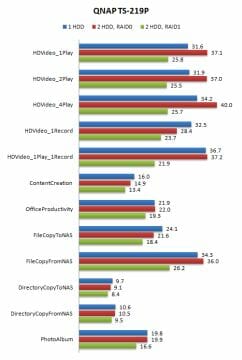
As you can see, the NAS offers rather high performance, delivering a read speed of 40MBps and a write speed of 30MBps. A RAID0 is somewhat faster than a single HDD while a RAID1 is, on the contrary, somewhat slower than the latter. The only disappointing fact is that the write speed of the striped array is lower.
I have not tested other NASes based on a similar platform, so I can’t make comparisons as yet, but the performance meets my expectations. Interestingly, QNAP and other makers have also decided to utilize the Marvell 6281 processor in their new mainstream models but use an 800MHz version of it rather than the TS-219P’s 1.2GHz version. And they install less memory. Such differences in hardware configuration are not crucial for moderately loaded NASes, though.
Compared to the top-performance platform from QNAP, the TS-219P is only half as fast as it.
QNAP’s newer firmware versions allow formatting a disk volume with data in EXT4 which is declared to have higher performance. This should have a positive effect on NASes with their rather limited platform resources.
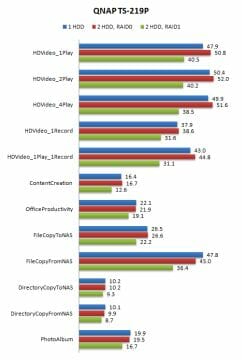
The numbers say that the EXT4 file system is indeed faster in most cases, up to 50% when reading sequentially located data from a single HDD and from a mirror. Writing improves less, yet the improvement is clear, too. It is very nice to get a 30% performance boost by simply changing the file system. The templates consisting of many small files are less sensitive to the change. Occasionally, the performance is even lower with the new file system. On the other hand, processing large files such as disc images is more important than processing lots of small ones. The maximum speeds are 52MBps when reading and 39MBps when writing. I didn’t spot any negative effect from using EXT4, so I recommend this file system for formatting disk volumes.
Conclusion
The QNAP TS-219P is a high-quality, functional and fast midrange solution. Its performance is high enough for a home network or a small workgroup. QNAP’s firmware offers a broad selection of integrated features and this functionality can be extended further if necessary. The only downside I can find is that the BitTorrent client is not very functional, but you can solve this problem by installing a third-party alternative. The integrated video surveillance system supports two IP cameras without your having to pay extra for licenses.
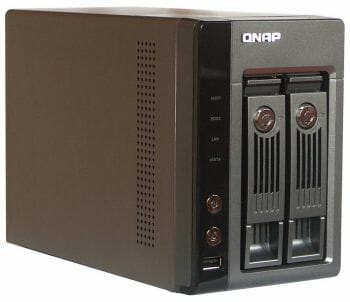
The quality of manufacture is high. The device’s robust case is designed stylishly and will look appropriate in any interior. The thought-through ventilation keeps the fan’s noise low while preventing the HDDs from overheat.
The TS-219P also offers broad connectivity. With two eSATA ports, it is not unlike a 4-disk NAS.
The device cost about $400 at the time of my tests and seemув to be absolutely worth the money.